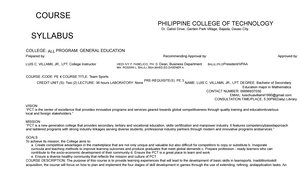- Information
- AI Chat
Was this document helpful?
EE2322 2021T2 3EEB WS03 Tumaneng
Course: Education (EDUC 2)
122 Documents
Students shared 122 documents in this course
University: Philippine College of Technology
Was this document helpful?

WORKSHOP 3
Tumaneng, Jm Kaye A.
3EEB
A) Arias, Mariz et al. 2017. “Prediction of electric vehicle charging-power demand in realistic urban
traffic networks”. Applied Energy, volume 195, pp. 738-753. Science Direct.
B) Gutierrez, Carlito M. 2006. “Improvement on the Design and Utilization of a Laboratory Trainer on
Motor Control Laboratory”. UST Graduate School. UST MdB Library Catalog.
This research is classified as Quantitative since the data that was gathered are concerned
in interpreting or comparing the effect of a laboratory trainer on motor control laboratory or the
traditional laboratory approach. I also think it is under the Non-probability sampling type of
research because the respondents were not chosen randomly.
C) Mendezabal, Marie Jean and Tindowen, Darin Jan. 2018. “Improving student’s attitude, conceptual
understanding and procedural skills in differential calculus through Microsoft Mathematics”. pp385-
397Journal of Technologiy and Science Education
This research is classified as Experimental since it was designed to assess if there is an
effect or improvement to the performance of the students in studying Differential calculus with the
help of the software called the Microsoft Mathematics compare to learning it in the traditional
way. The cause and effect were also identified making this another reason why it falls for the
Experimental type of research. The cause, which is studying Differential calculus with two
different settings, one in the traditional way and the other is with technology. And the effect, which
is the students that learned Differential calculus with the help of technology performed greater
than those students who learned in the traditional way.











